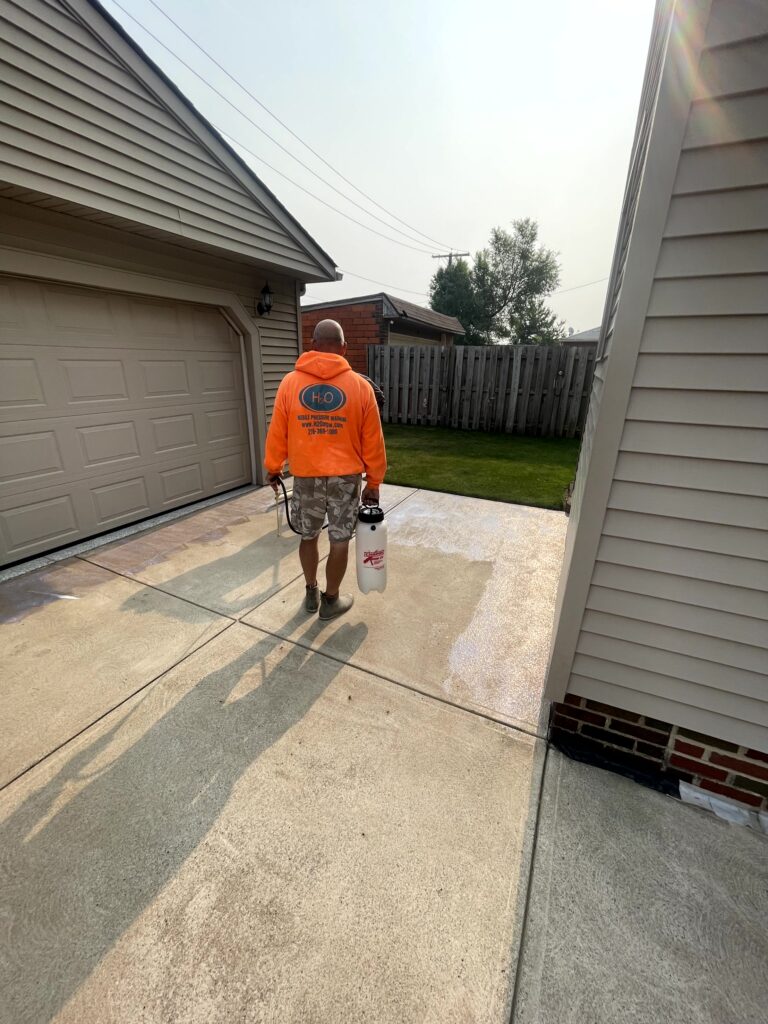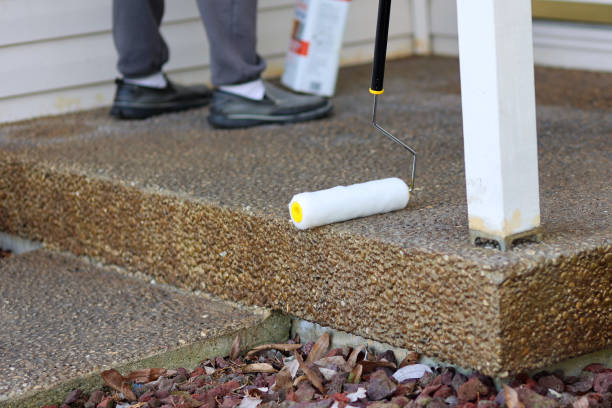
Concrete is one of the most widely used materials in construction due to its durability, versatility, and cost-effectiveness. However, while concrete is inherently robust, it is not immune to damage from environmental elements, chemical exposure, and regular wear and tear. Sealing concrete has become a standard practice to protect and enhance the performance and appearance of concrete surfaces, whether they are in residential, commercial, or industrial settings. This article explores the benefits of concrete sealing, highlighting manufacturers’ recommendations, relevant studies, and expert insights.
1. Why Seal Concrete?
Concrete is a porous material, meaning it can absorb moisture, oils, chemicals, and other substances that can degrade its structure over time. Concrete sealing is the application of a protective layer over the surface to prevent penetration by water, oils, chemicals, and dirt. According to industry leaders like Sika and BASF, sealing concrete not only helps prevent premature degradation but also enhances its appearance and extends its lifespan.
Concrete sealing serves several critical purposes:
- Prevention of water absorption: Water infiltration can cause cracking, spalling, and even structural failure.
- Protection from chemical damage: Sealing blocks chemicals, oils, and salts from permeating the surface.
- Reduced surface wear: By providing a protective layer, sealing reduces the impact of abrasion.
- Enhanced appearance: Many sealers add a sheen or color enhancement, improving the visual appeal of concrete surfaces.
2. Types of Concrete Sealers
Concrete sealers come in various types, each designed for specific applications and benefits. Choosing the right sealer depends on the location, environment, and type of concrete surface.
- Penetrating Sealers: These sealers, including silane, siloxane, and siliconate-based products, penetrate into the concrete’s pores. They offer invisible protection without altering the concrete’s appearance. Penetrating sealers are commonly used for driveways, sidewalks, and other outdoor applications.
- Acrylic Sealers: Often used in residential applications, acrylic sealers form a thin layer on the concrete surface. They offer excellent UV resistance and are ideal for patios, sidewalks, and pool decks.
- Epoxy and Polyurethane Sealers: Known for their durability and resistance to heavy wear, epoxy and polyurethane sealers are commonly used in industrial and commercial settings. They are especially suitable for floors that experience heavy traffic, such as warehouses and factories.
- Polyaspartic Sealers: Polyaspartic sealers are often recommended for projects that require quick curing. These sealers offer high resistance to abrasion, chemicals, and UV exposure.
3. Manufacturers’ Recommendations on Concrete Sealing
Leading manufacturers such as Sika, BASF, and Euclid Chemical provide detailed guidance on concrete sealing, based on years of research and testing.

Sika’s Recommendations
Sika recommends sealing exterior concrete, especially driveways, every 2–3 years. For interior floors, the company suggests a thorough cleaning followed by reapplication of a sealer every 3–5 years, depending on usage. Sika’s product line includes both penetrating sealers and surface coatings designed to withstand various conditions, from freeze-thaw cycles to heavy industrial traffic.
BASF’s Guidance
BASF, known for its innovative construction chemicals, advises customers to seal concrete shortly after it has fully cured (typically within 28 days of pouring). The company highlights the importance of matching the sealer type to the environmental exposure. For example, BASF recommends using epoxy-based sealers in settings exposed to chemicals and salt, while suggesting silane-based products for exterior surfaces.
Euclid Chemical’s Best Practices
Euclid Chemical emphasizes the importance of surface preparation, noting that improperly prepared concrete may not bond well with sealers. Their recommendation is to thoroughly clean and dry the surface before applying a sealer. Euclid also advises checking the concrete’s moisture levels before applying certain sealers, as high moisture content can prevent some sealers from bonding properly.
4. Benefits of Concrete Sealing
a) Increased Durability and Longevity
Concrete is naturally durable, but exposure to the elements can degrade its strength. Sealing concrete helps prevent common issues like cracking, spalling, and corrosion. Studies show that sealed concrete can last up to 30% longer than unsealed concrete, as sealing reduces water absorption, which is a leading cause of concrete damage (Khan & Hasan, Journal of Construction Engineering).
b) Protection Against Water and Chemical Damage
Sealing creates a barrier that prevents water, chemicals, and oils from penetrating concrete’s porous surface. In colder climates, this is especially important, as freeze-thaw cycles can lead to cracks and damage. A study conducted by the American Concrete Institute found that concrete exposed to freeze-thaw cycles without a protective sealer showed a significantly higher rate of spalling.
c) Enhanced Aesthetic Appeal
Sealers can enhance the appearance of concrete, bringing out its natural color and providing a glossy or matte finish. Decorative concrete, such as stamped or stained concrete, benefits from sealing, as it protects the aesthetic qualities while preventing color fading.
d) Reduced Maintenance Costs
While the upfront cost of sealing can be an investment, it can lead to lower maintenance costs over time. Concrete that remains sealed is less likely to require expensive repairs or replacements, particularly in high-traffic or industrial areas.
e) Improved Safety
Many sealers offer slip-resistant properties, which can improve the safety of wet surfaces. Manufacturers often add anti-slip aggregates to sealers intended for exterior or commercial applications, making sealed surfaces safer for pedestrians.

5. Environmental Considerations and Innovations in Concrete Sealing
Concrete sealing technology has advanced significantly, with manufacturers focusing on environmentally friendly formulations. Water-based and low-VOC sealers are now commonly available, reducing the environmental impact of sealing processes. These eco-friendly options are particularly suitable for interior spaces and locations with stringent environmental regulations.
6. Application Tips for Effective Concrete Sealing
The effectiveness of concrete sealing largely depends on proper application. Below are general steps for successful sealing:
- Clean the Surface: Remove dirt, oil, and other contaminants.
- Check Moisture Levels: Some sealers may require the concrete to be dry.
- Choose the Right Sealer: Match the sealer to the application area and environment.
- Apply Evenly: Use a roller or sprayer to apply the sealer evenly.
- Allow Curing Time: Follow the manufacturer’s curing recommendations.
7. Common Misconceptions about Concrete Sealing
Despite its proven benefits, some misconceptions persist:
- “Concrete doesn’t need sealing.” While concrete is a strong material, it is still vulnerable to environmental damage. Sealing is essential for longevity, particularly for exterior concrete.
- “Sealing concrete is a one-time process.” Over time, even the best sealers wear down due to exposure to weather and traffic. Reapplying sealant every few years is recommended.
8. Cost-Benefit Analysis of Concrete Sealing
The cost of sealing concrete can vary based on the sealer type and application area. However, when weighing the cost of sealing against potential repair and replacement costs, the investment often proves worthwhile. For example, resealing a driveway every few years can prevent cracks and degradation that would necessitate costly repairs.
9. Conclusion
Sealing concrete is a crucial step in maintaining its integrity, appearance, and performance over time. Whether for a residential driveway or an industrial warehouse floor, sealing helps protect concrete from damage, reduces maintenance costs, and enhances its visual appeal. Leading manufacturers like Sika, BASF, and Euclid Chemical emphasize the importance of choosing the right sealer for each application and following best practices for application. With advancements in eco-friendly sealers and improved durability, concrete sealing continues to be a practical, cost-effective solution for long-term concrete care.
Sources
- American Concrete Institute. “Durability of Sealed Concrete in Freeze-Thaw Conditions.” Journal of Construction Engineering, vol. 54, no. 3, 2019.
- Sika Corporation. “Concrete Sealing and Protection.” Sika Corp., 2023.
- BASF Construction Chemicals. “Best Practices for Concrete Sealing.” BASF Corp., 2022.
- Euclid Chemical. “The Importance of Surface Preparation in Concrete Sealing.” Euclid Chemical, 2021.
